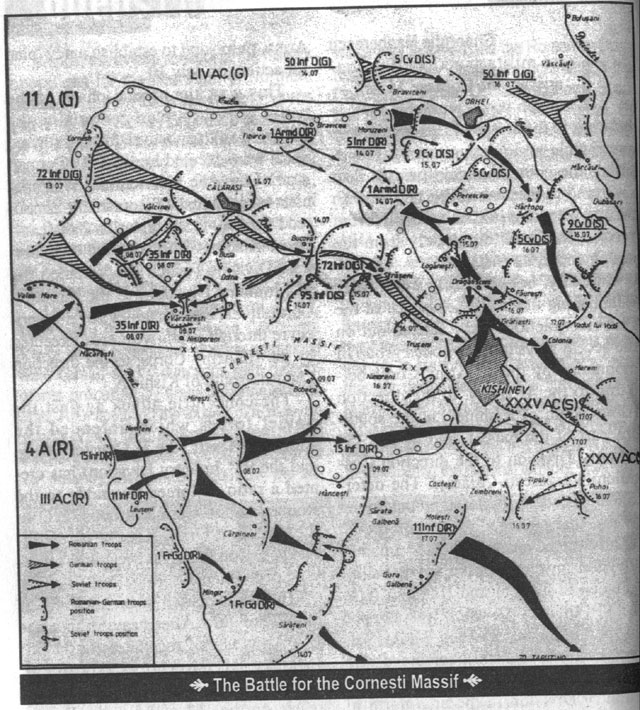 |  |  |
| Romanian Army in the Second World War · Forum Guidelines |
 Help Help
 Search Search
 Members Members
 Calendar Calendar
|
| Welcome Guest ( Log In | Register ) | Resend Validation Email |
   |
| dragos |
Posted: January 07, 2004 07:16 pm
|
 Admin Group: Admin Posts: 2397 Member No.: 2 Joined: February 11, 2003 |
by Gheorghe Tinica
The military actions for con-quering the Cornesti Massif - which was a powerful defence bulwark in the centre of Bessarabia, and meanwhile an important area for launching the counterattack towards Prut river and to the rear of the 11th German Army were carried in two different phases, this resulting mainly from the strong enemy's resistance. Initially, between July 6-10, after establishing the bridgeheads east of the Prut river, actions were carried out on the access ways to the wooded group of mountains by the III Army Corps belonging to the 4th Army, to the direction Albita-south of Kishinev, in the sout-ern part of the massif, and by the 35th Infantry Division to the direction Costiuleni-Varzaresti-Calarasi. The determinate resistance opposed by the Soviet forces, that managed to stop on the 9th of July the advance of the 15th Infantry Division on the Lapusna River Valley, between Stolniceni and Hancesti (also the 11th Infantry Division was stopped on the alignment between Sarata Galbena-east of Carpineni), combined with the grave defeat suffered by the 35rd Infantry Division in the area north of Miclauseni, obliged Marshal Ion Anto-nescu to give the order for ceasing the offensive on the entire front of the Army, purposing to establish a new plan for action, on July 10. This way, the second phase of the battle began, its plan comprising the following: a) manoeuvre from north and north-west excuted by the LIV German Army Corp (the 50th German, 5th Romanian Infantry and 1st Romanian Armoured Division) to the direction Zahaicani-Orhei-Kishinev and with the 72nd German Division (which subordinated the 35th Infantry Division) to the direction Cornesti-Calarasi-Kishinev; The concentric attack against the Soviet forces which defended the Cornesti Massif (the II Cavalry Corp and the 95th Infantry Division) has created a ratio of forces favorable to the Romanian and German troops (2/1) to the direction Orhei-Kishinev, respectively, 3/1 on the areas west and south-west of Kishinev. The battle started in the morning of the 14th of July. After heavy fights, the LIV Army Corps, together with the 50th Infantry Division, took Braviceni, Dascov and Seliste. Soon after, they reach, on the 16th of Jully, the Dniestr river's bank, as a result of an action undertaken in the area north of Orhei, thus keeping under control the crossing at Botuseni and Dubasari. The 5th Romanian Infantry Division carried heavy fights, rejecting manifold counterattacks in the area of Isacova, Moruzeni Forest, where the soldiers of the 8th, 9th and 32nd Dorobanti (Infantry) Regiments proved their heroism. They liberated the town of Orhei, in the afternoon of July 15 and reached, on July 17, the western bank of the Dniester River, between Dubasari and Balanesti. The 72nd German Division launched its offensive on July 14, at 05.30 a.m., concentrically attacking both on the Bucovat and Bacu Rivers Valleys. In the end of some heavy fights, the 241st and 90th Regiments belonging to the 95th Soviet Infantry Division stopped on the 15th of July the German division's offensive carried on the Bacu River Valley, west of Straseni. In the area south of the Cornesti Massif, the III Romanian Army Corps, including the 15th and 11th Infantry Division, started its offensive operation on the 14th of July and managed to reach, till the evening of July 16, an alignment in the area south of Kishinev, between Bacioiu and Molesti. The commander of the LIV Army Corps, grasping the existence of a big gap which was created between the forces acting at Orhei and on the Bacu River Valley, ordered to the 1st Armoured Division to advance through this open interval, towards Kishinev, with the view to reach the rear positions of the forces commited into the defence of the Cornesti Massif; in the same time, its troops were assigned to block the width of the Soviets forces towards the line of the Dniester River, by using the road between Kishinev-Tighina. As a result, the 1st Romanian Armoured Division moved trough the area Pocsesti, Kishinev and fired a Soviet unit with its cannons, managing to disperse it. The intervention of the Romanian Armoured Division in this wooded area, which was very moulded, had as a result, initially, the conquer of the intermediate defence alignments organized by the enemy in the area of Rascani, Stavilenii Noi, Colonia localities; then, until the evening of the 15th of July, the alignment north of Mihai Viteazul, Odaia lui Manoil, at only 8 km distance from Kishinev, where from the view of the burning city was clearly perceived, was also reached.  |
1 User(s) are reading this topic (1 Guests and 0 Anonymous Users)
0 Members:
 |
   |
[ Script Execution time: 0.0074 ] [ 14 queries used ] [ GZIP Enabled ]
Powered by Invision Power Board(U) v1.3.1 Final © 2003 IPS, Inc.





